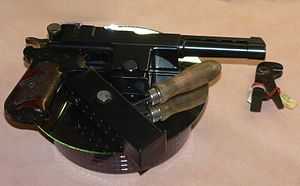Theodor Bergmann
| Theodor Bergmann | |
|---|---|
 Theodor Bergmann | |
| Born |
Benjamin Berkeley Hotchkiss May 21, 1850 Sailauf, Germany |
| Died |
March 23, 1931 (aged 80) Gaggenau, Germany |
| Occupation | gunsmith, engineer |






Theodor Bergmann (May 21, 1850 in Sailauf - March 23, 1931 in Gaggenau)[1] was a German businessman and industrialist best remembered for the various revolutionary firearms his companies released. Like many entrepreneurs of the era, his activity was centered on bicycles and the nascent automobile. Armament was not Bergmann's primary focus, but the one he had more attraction to, which was the reason most of his pistols were manufactured under license once they were created, creating pistols and their ammunition.
Theodor Bergmann sold his automobile activity to Carl Benz in 1910.
The first automatic pistol was made by the Clair brothers working in Saint-Étienne, France using the newly appeared smokeless powder, created by Paul Vieille in 1884 and used in the 1886 Lebel rifle, built a pistol in 1888 using a 8mm round derived from the Swiss 7.5mm 1882 round, but it was rejected by the French Army.
The first pistol to be really manufactured with a significant number was designed by an Austrian, Joseph Laumann, and made by Osterreichische Waffenfabrik Gesellschaft, Steyr in 1892. It was called the Schönberger-Laumann and drew an immediate success. OWG later manufactured the Mannlicher 1894.
In 1893, Borchardt and Bergmann first pistols were already proposed in Europe and in America. The Borchardt evolved into the Borchardt Luger then into the Luger or Parabellum as known in Europe and became one of the most famous pistols in the world.
A new Bergmann model pistol was patented every year:
- Bergmann 1893
- Bergmann 1894
- Bergmann 1895
- Bergmann 1896
- Bergmann 1897 aka Bergmann Pieper
- Bergmann 1898
- Bergmann 1899
- Bergmann 1901 aka Bergmann Simplex
- Bergmann Mars
- Bergmann 1905
- Bergmann 1908 aka Bergmann-Bayard 1908
- Bergmann 1910 aka Bergmann-Bayard 1910
- Bergmann 1910/21 aka Bergmann-Bayard 1910/21
Bergmann designed the Bergmann MG15 nA Gun a LMG using a locking system he patented in 1901. It was used until World War II as the MG 15 machine gun
In 1915, the German Rifle Testing Commission at Spandau decided to develop a new weapon for trench warfare. The original intention had been to modify existing semi-automatic pistols, specifically the Luger and C96 Mauser. However, the mechanisms of these pistols were not suited to the stresses of full automatic fire, let alone the dirt and debris of the typical battlefield along with light weight weapons being difficult to control in full automatic fire. Based upon this, the Commission determined that a completely new kind of weapon was needed.
Hugo Schmeisser, working for the Bergmann Waffenfabrik, was part of a team that designed a new type of weapon to fulfill the requirements, which was designated the MP18 or Maschinenpistole 18/I.
Theodor Bergmann's company still exists today as a plastics manufacturer.
Bibliography
- Gotz, Hans Dieter, German Military Rifles and Machine Pistols, 1871-1945, Schiffer Publishing, Ltd. West Chester, Pennsylvania, 1990. OCLC 24416255
- Schroeder, Joseph J., "Theodor Bergmann, ein Berühmter Name aus den Anfangszeiten der Selbstlader Pistolen" in Waffen Digest '83, Verlag Stocker-Schmid AG/Motorbuch Verlag, Zurich, 1982
- Smith, W.H.B., Small Arms of the World: The Basic Manual of Military Small Arms, Harrisburg, Pa. : Stackpole Books, 1955. OCLC 3773343
- Günter Wollert; Reiner Lidschun; Wilfried Kopenhagen, Illustrierte Enzyklopädie der Schützenwaffen aus aller Welt : Schützenwaffen heute (1945-1985), Berlin : Militärverlag der Deutschen Demokratischen Republik, 1988. OCLC 19630248
- Clinton Ezell, Edward, Small Arms of the World, Eleventh Edition, Arms & Armour Press, London, 1977
- Deutsches Waffen Journal
- Visier
- Schweizer Waffen Magazin
- Internationales Waffen Magazin
- Cibles
- AMI
- Gazette des Armes
- Action Guns
- Guns & Ammo
- American Handgunner
- SWAT Magazine
- Diana Armi
- Armi & Tiro
Notes
External links
- Theodor Bergmann in German
- Guns & Ammo, May 2003 Bergmann pistols
- Pieper Belgium licensed manufacturer of Bergmann pistol under the brand Bergmann Bayard.
- 9mm Largo, 9mm Bergmann
- MG15
- MP 18.1 Video, Informations and Pictures
- A Bergmann MP 18 built in Tsing Tao, China in 1927
- Historic Arms
- [http://www.rediscov.com/spring/VFPCGI.exe?IDCFile=/spring/DETAILS.IDC,SPECIFIC=462,DATABASE=objects, Springfield Armory's Villar Perosa]
|